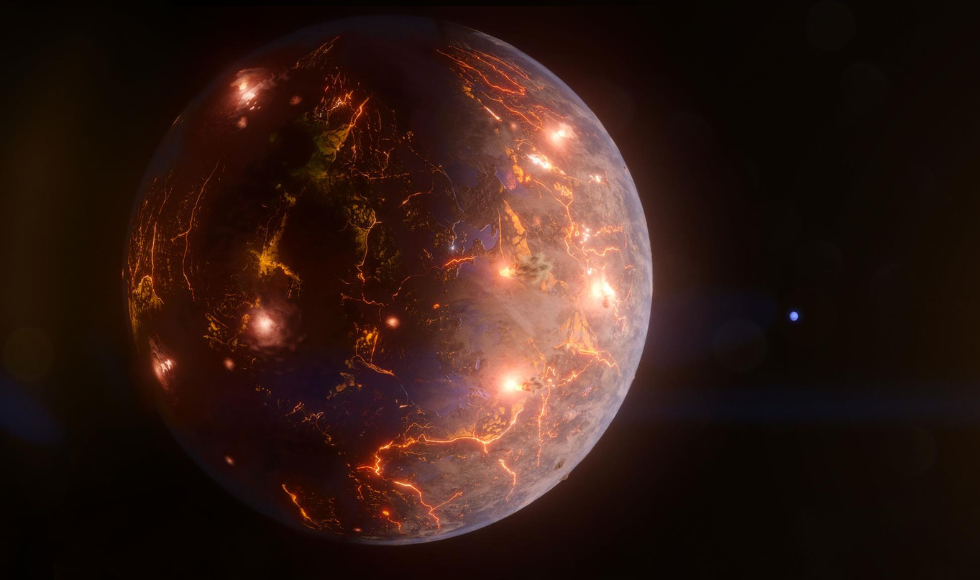Researchers find new exoplanet, potentially covered in volcanoes

LP 791-18 d, illustrated here, is an Earth-size world about 90 light-years away. The gravitational tug from a more massive planet in the system, shown as a blue disk in the background, may result in internal heating and volcanic eruptions – as much as Jupiter’s moon Io, the most geologically active body in the solar system. Astronomers discovered and studied the planet using data from NASA’s Spitzer Space Telescope and Transiting Exoplanet Survey Satellite along with many other observatories. (Image from NASA’s Goddard Space Flight Center/Chris Smith)
May 17, 2023
An international team of astronomers, including a key researcher from McMaster, has discovered a unique Earth-sized exoplanet that may be carpeted with volcanoes.
The planet, known as LP 791-18 d, could undergo volcanic outbursts as frequently as Jupiter’s moon Io, the most volcanically active body in our solar system.
Research led out of the University of Montréal and NASA discovered and studied the planet using data from NASA’s Transiting Exoplanet Survey Satellite (TESS) and retired Spitzer Space Telescope, as well as a suite of ground-based observatories. Spitzer’s observations of the system were among the last the satellite collected before it was decommissioned in January 2020.
The findings are published today in the journal Nature.
“What makes this newly discovered planet particularly interesting is its unique orbital configuration that may sustain active volcanism on the planet’s surface,” says Ryan Cloutier, an assistant professor in McMaster’s department of Physics & Astronomy, who worked on the discovery.
“We observed many transits of this planet and watched it get tugged back and forth by another planet in the system. These observations allowed us to measure the planet’s mass and infer the strength of tidal heating that may give rise to extreme volcanism.”
For the study, Cloutier worked to obtain and analyze observations from the Las Cumbres Observatory, a global telescope network that covers the entire globe, and MEarth, which is an array of eight individual telescopes optimized to look at low mass stars like LP 791-18, which the new exoplanet orbits.
Those observations, gathered over 20 months , were used to confirm the physical nature of the new planet and measure its mass: A fundamental parameter that is required to distinguish between an Earth-like rocky composition, and a Neptune-like composition that is largely composed of gas.
Scientists also reported the planet is tidally locked, meaning the same side constantly faces its star.
“The day side would probably be too hot for liquid water to exist on the surface,” said Björn Benneke, the corresponding co-author and astronomy professor, who planned and is directing the study with Merrin Peterson, a graduate student at the Trottier Institute for Research on Exoplanets (iREx) based at the University of Montreal.
“But the amount of volcanic activity we suspect occurs all over the planet could sustain an atmosphere, which may allow water to condense on the night side.”
LP 791-18 d orbits a small red dwarf star about 90 light years away in the southern constellation Crater. The team estimates it’s only slightly larger and more massive than Earth.
Astronomers already knew about two other worlds in the system before this discovery, called LP 791-18 b and c. The inner planet, b, is about 20 per cent bigger than Earth. The outer planet, c, is about 2.5 times Earth’s size and more than seven times its mass.
During each orbit, planets d and c pass very close to each other. Each close pass by the more massive Planet c produces a gravitational tug on Planet d, making its orbit somewhat elliptical. On this elliptical path, Planet d is slightly deformed by tides every time it goes around the star. These deformations can create enough internal friction to substantially heat the planet’s interior and produce volcanic activity at its surface. Jupiter and some of its moons affect Io in a similar way.
Planet d sits on the inner edge of the habitable zone, the traditional range of distances from a star where scientists hypothesize liquid water could exist on a planet’s surface. If the planet is as geologically active as the research team suspects, it could maintain an atmosphere. Temperatures could drop enough on the planet’s night side for water to condense on the surface.
Planet c has already been approved for observing time on the recently launched James Webb Space Telescope, and the team thinks Planet d is also an exceptional candidate for atmospheric studies by the mission.
“A big question in astrobiology, the field that broadly studies the origins of life on Earth and beyond, is if tectonic or volcanic activity is necessary for life,” said co-author Jessie Christiansen, a research scientist at NASA’s Exoplanet Science Institute at the California Institute of Technology in Pasadena.
“In addition to potentially providing an atmosphere, these processes could churn up materials that would otherwise sink down and get trapped in the crust, including those we think are important for life, like carbon.”

